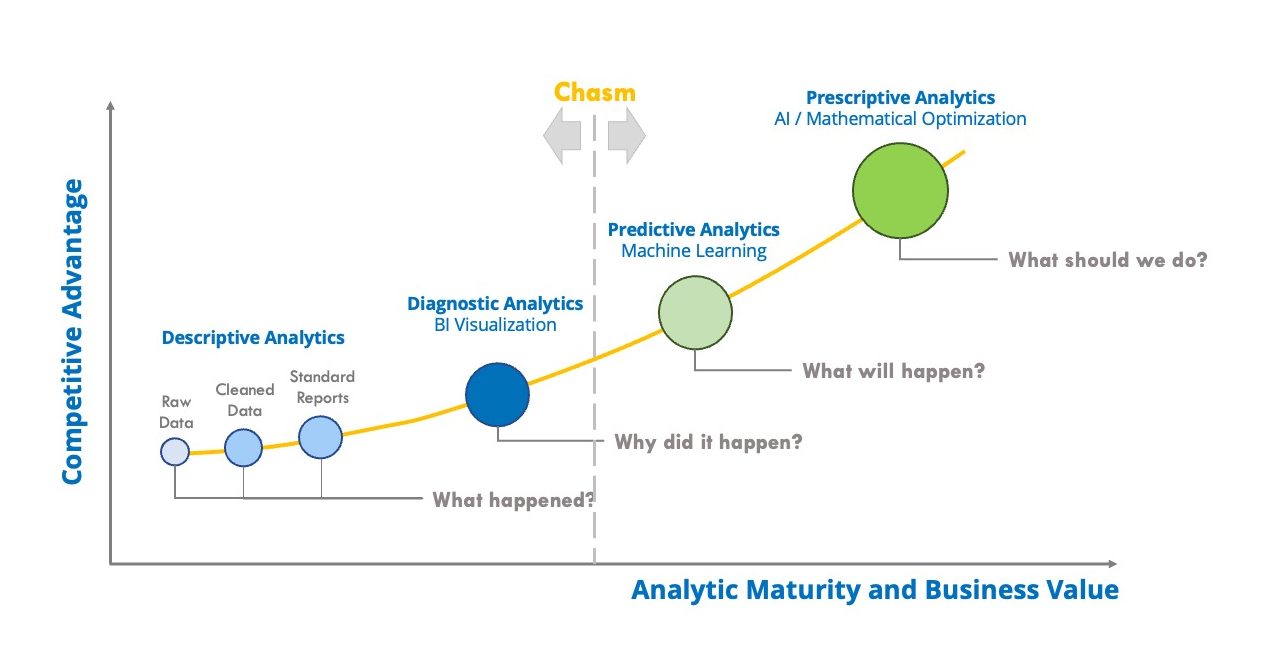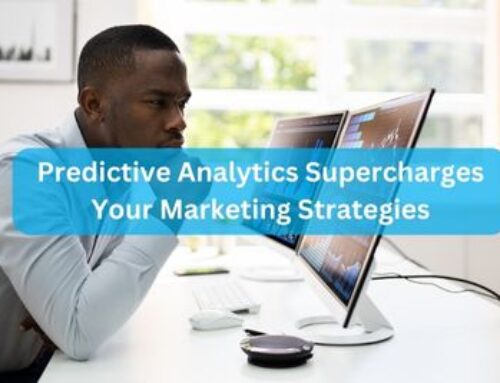Are you responsible for ensuring your company or group is profitable and growing?
As with many in your same position, you likely understand the importance of data and analytics on your organization’s bottom line. However, if you don’t fully understand an important—and possibly more valuable—difference between advanced analytics and non-advanced or simple analytics, please keep reading.
This brief article will help clarify how these two approaches differ while each remains highly critical to your business. Additionally, while the debate between “analytics” and “advanced analytics” can be fun, this article is focused on helping you better understand how each can help improve or solve a business challenge—not the technical aspects of how.
To start, it is worth understanding at least a bit about what it means when you hear someone say “Advanced Analytics,” since it implies additional benefits not available with less advanced analytics. So, here you’ll read about some of the benefits of advanced analytics that you cannot get as quickly, as accurately, or often at all, out of more simple analytics.
A definition…
Generally, analytics is the examination of information/data to gain insight to assist with improved decision making and strategy. Defining advanced analytics takes the basic definition and then adds: using more intensive and/or granular techniques and methodologies that require greater skill, experience, tools, and understanding to (hopefully) improve decision making and strategy. The additional parenthetical of “hopefully” gets included, because there is no guarantee that using advanced analytic approaches will absolutely deliver better insights.
Outcomes are impacted by several factors, such as:
- Depth, breadth, and quality of the data
- The ability to apply the approach correctly
- Whether the chosen method is the right one
The two most commonly recognized examples of advanced analytics today are machine learning and artificial intelligence.
As you might imagine, there are many analytic approaches that qualify as advanced, thus when dividing analytics up into the two types, advanced and non-advanced, it is easier to talk about what is “non-advanced” and leave everything else as “advanced” given the explosion of advanced capabilities that continue to enter the analytics category.
Non-advanced analytics
As a basic rule, non-advanced analytics is almost always backward-looking. This means that simple analytics is an examination of data and results to learn what happened or why it happened, and it is most commonly presented as reports or decks with summary statements, findings, tables, and charts.
There are many tools available for performing and delivering non-advanced analytics, and the value is and will always be high, while the level of effort is relatively low. You need this type of analytics to tell you what is happening, to help you manage your business, to share performance, and communicate with key stakeholders, etc.
This type of analysis will always be around and will remain valuable. What has happened though, is where it once was considered advanced to have some of this insight, it is now table stakes for every business, while becoming more accessible, less expensive, and faster to produce.
An important distinction and potential downside to this type of analytics is that it requires significant interpretation. There remains a “so-what” gap also known as an “insights-to-action gap” which raises additional questions about what the results are actually saying about what you should do differently, and why?
Those questions can be challenging to answer when sorting through simple analytics figures and charts.
Advanced Analytics
The analytics lifecycle graphic (below) is a straightforward way to represent increasing levels of analytics, offering a clarifying separation for advanced analytics.
 On the non-advanced side, the left side of the analytics chasm, are descriptive and diagnostic analytics. These leverage reporting and the use of business intelligence tools to examine what has occurred to explain what happened and why.
On the non-advanced side, the left side of the analytics chasm, are descriptive and diagnostic analytics. These leverage reporting and the use of business intelligence tools to examine what has occurred to explain what happened and why.
To the right of the chasm, predictive analytics looks forward and helps predict what will happen using techniques such as machine learning. This level and use of analytics has expanded with an increase in available tools. And, the data science experience required to use such tools has decreased over time.
The next stage in the lifecycle, prescriptive analytics, takes predictive insights and leverages them to determine the best actions for achieving a specific outcome. This is a type of Artificial Intelligence (AI), and as an example, at Lityx, we use a technique called mixed-integer programming that performs mathematical or constrained optimization to deliver this type of insight. The field of AI goes well beyond the scope of this article, but with better platforms comes better ways to use data to improve your business.
Advanced analytics evolves more and more each day, which is often the case with innovative tools and techniques. One key difference with advanced analytics is that it dramatically closes the insights-to-action gap. The answers you find in advanced analytics inform you or in some cases specifically, tell you the best or optimal path to take.
Non-advanced analytics can then be helpful with digging deeper into why the solution recommended is best.
An excellent example of advanced analytics at work
A Lityx client was using a combination of counts, averages, ratios, etc. along with a mapping tool to identify the best zip code locations to hold events—a labor-intensive process with no clear answer. The only important insight they could derive was best candidates to choose from for a given location, depending on the prioritization of factors. They were able to make better decisions than they could have without any analysis, but it was taking a long time, and they were missing out on the benefits of advanced analytic techniques.
The benefits of advanced analytics, in this case, were decreased turn-around time, freeing up staff, faster assessment of different scenarios and, most importantly, immediate, specific and better recommendations through a review of a much wider variety of information simultaneously.
These benefits are all possible because of advances in computer power and tools to support a wider variety of advanced techniques.
In this case, we built predictive models from historic results that looked ahead into existing or new markets to make accurate predictions on a variety of performance or cost measures. Then we combined all of the predictions, required business rules, and desired outcomes into a prescriptive analytic decision engine to identify all qualifying candidates and rank them from best to worst.
This rank was then duplicated using updated business rules or desired outcomes and compared over and over. In this way, the business manager can quickly receive and understand recommendations and tradeoffs to make the best decision.
The detailed level and accuracy of the insight available through advanced analytics is far greater than with non-advanced analytics.
The challenge, of course, is access to the resources and people who understand how to perform advanced analytics. Thankfully resources are more abundant than ever, but in high demand and so typically pricey. The tools that can perform advanced analytics vary in cost with the approach becoming more accessible every day.
Why should you know about and care about advanced analytics?
The short answer is that advanced analytics provides a competitive advantage both for the individual and the business.
You don’t need to understand all of the underpinnings of advanced techniques fully, but you should be in a position to leverage these techniques. Using advanced analytics, you can access very detailed and complicated insights such as the most optimal allocation of your marketing dollars across each of your audience, offer, and channel segments layered with numerous constraints (business requirements) that you must meet.
Through data and analytics there are more and more answers for previously elusive marketing questions. The sophistication of technology, software, and people who understand how to leverage them abounds. The challenge is to narrow down the questions, so they are answerable and then obtain the necessary data to find the answer.
Many seemingly unique challenges are increasingly solvable with readily available advanced analytics technologies and techniques.
To dive further, talk with a trusted source and continue to educate yourself, as tools get better every day.
You can receive more guidance and information about analytics by subscribing to the Lityx blog below, or please reach out any time to connect with one of our advanced analytics experts at Lityx. We look forward to hearing from you.
Subscribe to the Lityx Blog


